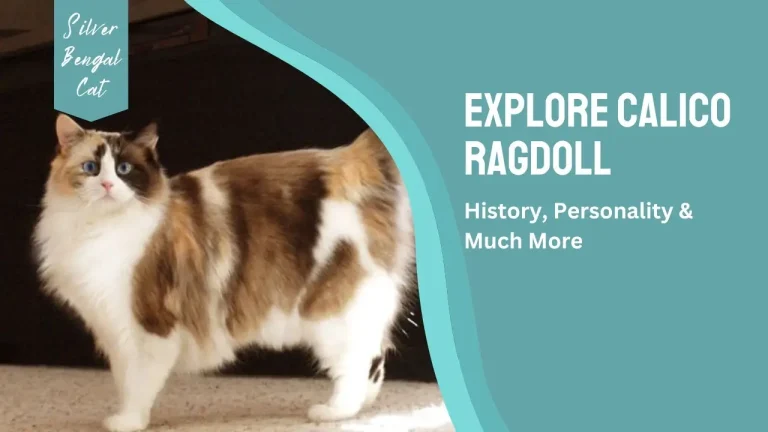Silver Bengal Cat Feeding Guidelines

Importance of a balanced diet cannot be ignored for all living creatures – the same goes for your Bengal cats, especially silver ones. Feeding your silver Bengal cat the correct quantity of a well-balanced diet is essential to maintaining general health and well-being. Understanding the specific dietary needs of silver Bengal cats is crucial to providing them with the appropriate nutrition.
Hence, ensuring the well-being of your silver Bengal cat is guaranteed when you provide them with the right amount of food and meet their nutritional needs. Failing to understand the dos and don’ts of feeding your cat can lead to significant health issues. To avoid this, it’s crucial to know your silver Bengal cat’s nutrition needs, such as the number of calories required for their diet.
What are some of essential Silver Bengal Cat feeding guidelines? How can you ensure your cat gets the proper nutrients from their food? This blog post covers critical topics such as cat nutrition, feline diet, homemade cat food, premium cat food, cat feeding schedule, and ingredients. By following these guidelines, you can ensure that your silver Bengal cat is healthy and happy.
Nutritional Needs of Silver Bengal Cat
The carnivorous nature of Bengal cats is well known. They will consume every meal you share with them but must consume meat for their nutrition needs. According to scientific research, the metabolism necessary for a true carnivore to properly consume plant stuff is absent.
Hence, these cats have grown dependent on nutrients only present in animal tissue, such as vital fatty acids, minerals, and vitamins.
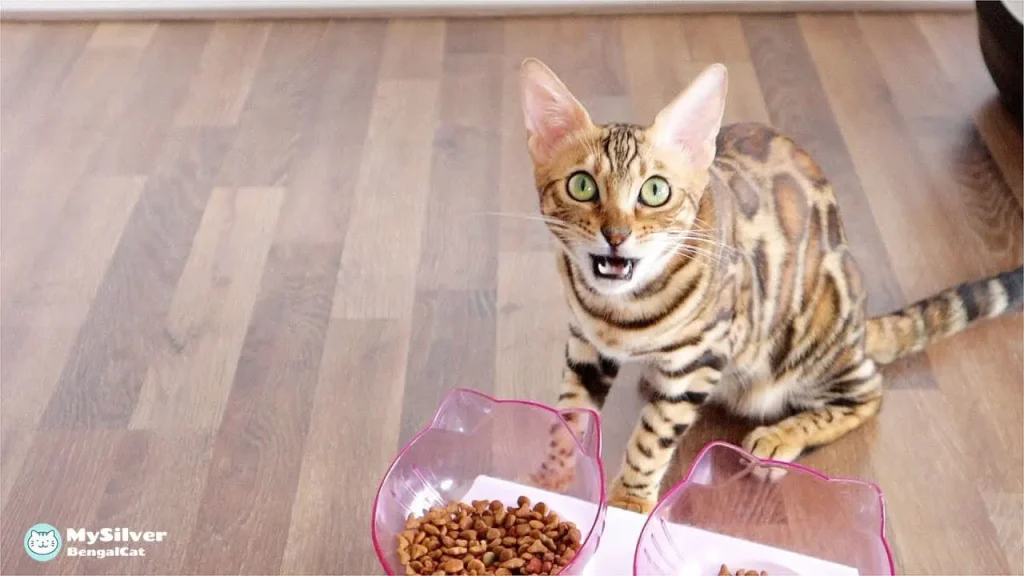
Bengal cats rely heavily on protein as their primary source of daily calories since they use it to maintain and repair tissue and carry out biological processes. It’s noteworthy that Bengal cats need less water than other mammals because of their origin.
Although they are given moist canned food, which meets their water needs, they should always have easy access to fresh drinking water. Bengal cats older than middle-aged and young cats have different nutritional requirements.
They frequently display a decreased capacity for protein metabolization, which causes them to lose muscle mass. They need more easily absorbed protein to maintain lean muscle mass and good health.
How Much to Feed Your Silver Bengal Cat
1. Age
Bengal cats can be fed adult food if they are older than ten months. Your cat needs energy because they are growing during this formative phase.
2. Physique
Bengal cats are bigger than other domestic breeds, as we already know. Additionally, because of the weight of their bones, they require more food to meet their body’s needs.
3. Metabolism
Cats who regularly exercise vigorously will burn through their energy quickly. They consume more calories and require more nourishment as they move more. Here we’ve discussed in detail 9 Ways to Exercise Your silver Bengal Cat.
4. Health
Additionally, several medical conditions might lead to weight gain or loss in cats. Your cat may need to lose some weight, for example, if they have cardiac problems that cause its arteries to become thick. However, if your vet advises that your Bengal needs to put on weight, you might need to give it more food than usual.
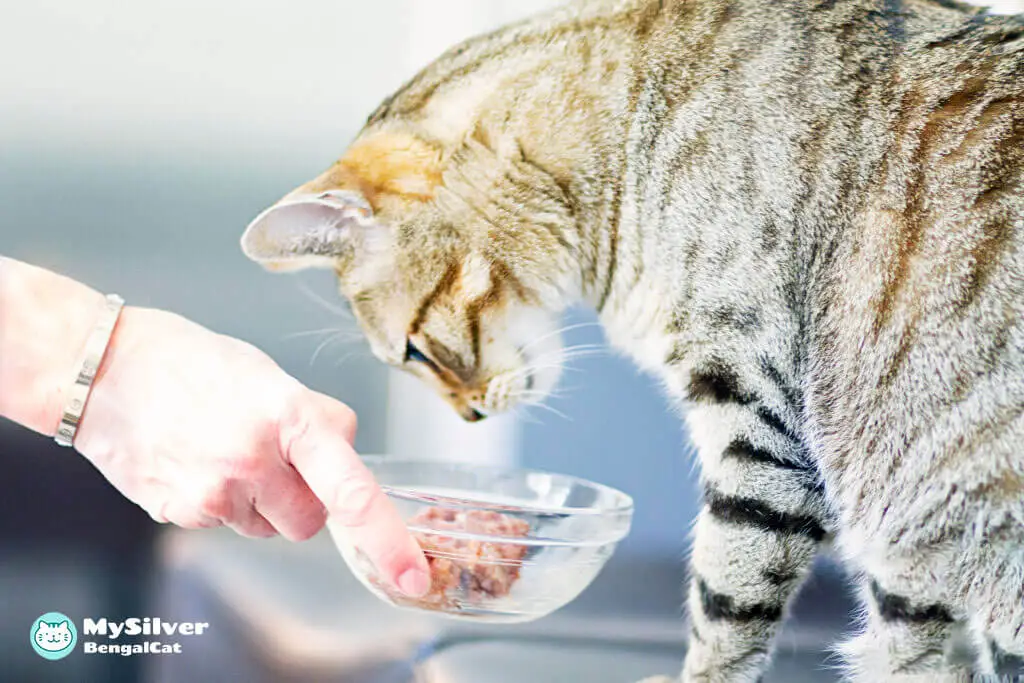
Eating Behavior of Bengal Cat
Bengal cats frequently graze throughout the day and take little meals. 12 to 20 meals may be consumed daily, depending on the person and the type of food. In general, cats like food that has a strong aroma.
This demonstrates that these cats can be picky eaters since they are strongly influenced by their food’s texture, odor, warmth, and flavor.
The practical way to feed a Bengal cat
This section is divided into two parts:
1. Practical ways to feed a Bengal cat below six months of age.
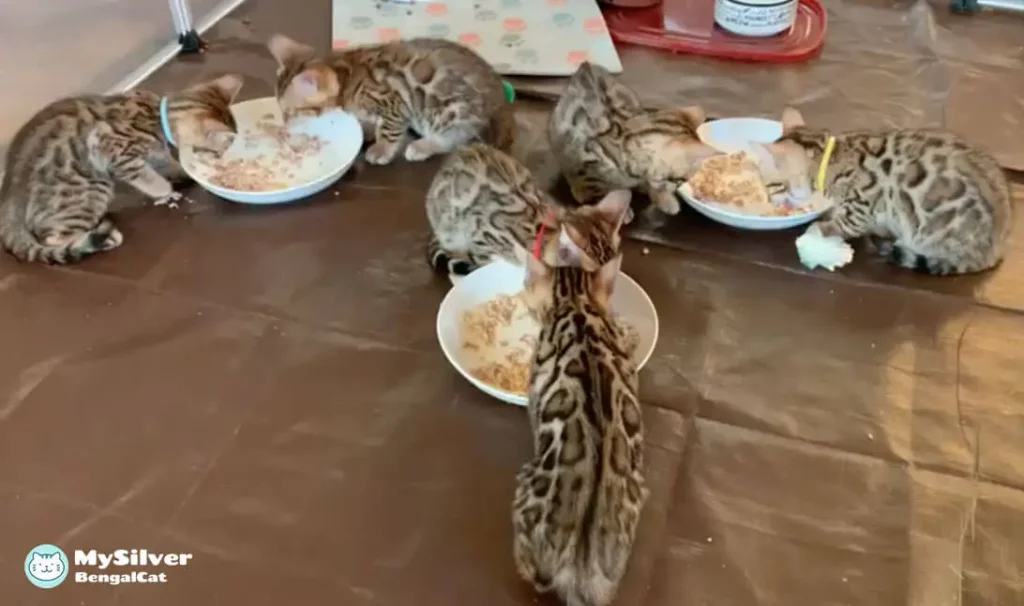
2. Now that your cat has grown up consider the following points
Silver Bengal Cat Feeding Chart
The table below will help you upscale your knowledge about feeding your Bengal cat in the right way.
| Age | Feeding Volume | Schedule |
|---|---|---|
| 0-1 Week | 2-6 ml kitten formula | Every 1 to 2 hours |
| 1-2 Week | 6-10 ml kitten formula | Every 1 to 2 hours |
| 2-3 Week | 10-14 ml kitten formula | Every 2 to 3 hours |
| 3-4 Week | 14-18 ml kitten formula | Every 3 to 4 hours |
| 4-5 Week | Ablactation: Offer 18-22 ml kitten formula; gradually switch to a mixture of kitten formula / wet kitten food | Every 4 to 6 hours |
| 5-8 Week | Ablactation: Offer wet kitten food | Every 6 hours |
| 8-9 Week | 250-360 calories per day | Every 6 to 8 hours |
| 9-10 Week | 250-360 calories per day | Every 6 to 8 hours |
| 10-11 Week | 250-360 calories per day | Every 6 to 8 hours |
| 11-12 Weeks | 250-360 calories per day | Every 6 to 8 hours |
| 12-13 Weeks | 250-360 calories per day | Every 6 to 8 hours |
| 13-14 Weeks | 250-360 calories per day | Every 6 to 8 hours |
| 14-15 Weeks | 250-360 calories per day | Every 6 to 8 hours |
| 15-16 Weeks | 250-360 calories per day | Every 6 to 8 hours |
| 4 Months | 60 to 65 calories (per pound of bodyweight) per day | Every 8 hours |
| 5 Months | 60 to 65 calories (per pound of bodyweight) per day | Every 8 hours |
| 6 Months | 60 to 65 calories (per pound of bodyweight) per day | Every 8 – 12 hours |
| 7 Months | 60 to 65 calories (per pound of bodyweight) per day | Every 8 – 12 hours |
| 8 Months | 60 to 65 calories (per pound of bodyweight) per day | Every 8 – 12 hours |
| 9 Months | 60 to 65 calories (per pound of bodyweight) per day | Every 8 – 12 hours |
| 10 Months | 60 to 65 calories (per pound of bodyweight) per day | Every 8 – 12 hours |
| 11 Months | 60 to 65 calories (per pound of bodyweight) per day | Every 8 – 12 hours |
| 12 Months – adulthood | 20 to 33 calories (per pound of body weight) per day | Every 8 – 12 hours |
Dry food vs wet cat food
To ensure that your Bengal cat is receiving the appropriate nutrition, it’s crucial to consider their physical requirements and living environment. Our team of dietary experts understands the importance of providing the best possible care for your cat, and we want to make it easier for you to make informed decisions about their diet.
That’s why we’ve put together a comprehensive comparison of dry cat food and wet cat food. By understanding the differences between these two types of cat food, you can choose the best option for your beloved Bengal cat. Also Read, Can a Silver Bengal Cat Eat Raw Food?.
| Feature | Dry Cat Food | Wet Cat Food |
|---|---|---|
| Moisture content | 10-12% | 75-80% |
| Shelf life | Longer shelf life can be left out. It only needs to be kept in a dry place. | Shorter shelf life, needs to be refrigerated once opened |
| Cost | Cheaper | More expensive |
| Convenience | Can be left out for longer periods, easy to store and serve | Needs to be refrigerated, not as convenient for storage or serving |
| Hydration | Provides minimal hydration, requires cats to drink more water | Provides high moisture content, can help with hydration |
| Dental Health | Can help reduce tartar buildup due to chewing | Does not provide the same benefits for dental health |
| Nutrient Content | Typically higher in carbohydrates and lower in protein | Typically higher in protein and lower in carbohydrates |
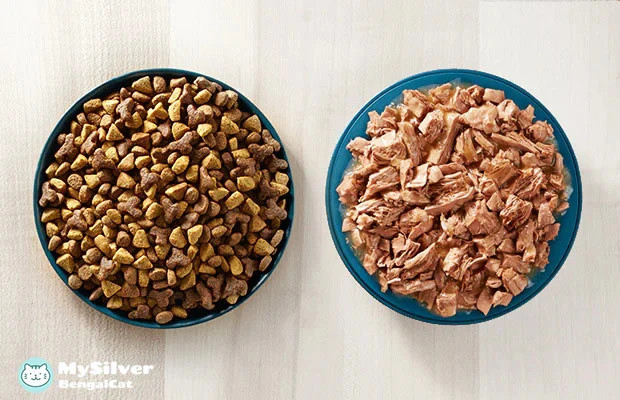
Concluding Thoughts
Similar to how eating a well-balanced diet is vital for people, feeding your Bengal cat the correct quantity of a well-balanced diet is essential to maintaining general health and well-being.
Understanding how cats’ dietary needs have changed due to biological evolution is vital to know how and what to feed them. We hope that this blog enlightened you about feeding your Bengal cat appropriately.


